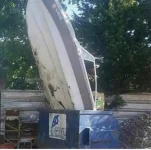
|
| Daniel Avila/New York City Department of Parks & Recreation |
He has found what he expected to find, pleasure boats, 78 in the last 12 months, mostly 20- to 30-footers whose owners probably couldn’t afford them anymore. The owners left them where they ran aground or sank in not-very-deep water, and simply walked away.
Grove is the Parks Department official behind a push to clear abandoned boats from around the city — vessels that have been left on or near the shoreline.
There are a lot of derelict boats — more than 800, the city says. There is also a lot of shoreline, 520 miles in all, which Grove likes to point out is more than the shorelines of Boston, Miami, San Francisco, San Diego and Seattle combined.
Almost a third of the city’s long shoreline is parkland, which means that Grove has jurisdiction through the Parks Department office responsible for marine debris disposal. And because 12 public marinas are on city parkland, the department started a vessel turn-in program for people to surrender their unwanted boats before they become derelict.
Partially submerged wrecks pose obvious risks to navigation and to what the Parks Department calls “waterfront enjoyers” like swimmers and surfers. But Parks Department officials say that the vessels are also environmental hazards. Most pleasure boats have fiberglass hulls, which can break down and release microplastics into the water. And oil and fuel can leak out of tanks as they rust, upsetting sensitive marine ecosystems.
Grove isn’t expecting to find the likes of the General Slocum or Captain Kidd’s ship, the Adventure Galley. “I don’t want to make this sound more romantic than it is,” Grove said. “Rare is the really interesting craft.”
But when it comes to recreational vessels, “I see the life cycle” of the boat, he said.
Someone probably bought a boat at a discount, perhaps from a neighbor who wanted to unload it, he said. “Then they find out gas costs a lot,” he explained before repeating the nautical quip that the word “boat” is an acronym for “bust out another thousand.”
As a pleasure boat ages, he said, “You can’t just find a cheap mechanic — these things are costly.” And a boat is “the first thing that gets cut when their budget gets tight.”
Worse, if the engine has conked out, “there’s no resale value,” he said. The fiberglass hull means that there’s no scrap metal to salvage and sell.
“People can scratch the identification off their boat,” hoping to keep the vessel from being traced back, and then abandon it, he said. That is a crime, but one that is not often prosecuted. The Army Corps of Engineers can haul away abandoned vessels that block major navigation channels like the East and Hudson Rivers, and the United States Coast Guard can move recreational boats that are leak fuel or obstruct rights of way.
The city began cleaning up marine burial grounds after Hurricane Sandy, first with a $2 million federal grant that focused on the removal of more than 50 boats in places like Eastchester Bay in the Bronx and College Point in Queens. Grove brought an urgency to the effort that included updating city regulations on when and how abandoned eyesores could be removed.
“We’re a maritime city — that’s what made Manhattan Manhattan back in the day,” Grove said. “Yet what I found was a woefully behind-the-times set of regulations and procedures for dealing with recreational craft. We’re stuck in the 1800s, when wrecks were referred to as something worth something, when it was presumed they had valuable cargo, rather than reflecting the current reality, when it’s recreational craft that litter our shorelines.”
In January, the city hauled away a boat that was half-buried off Breezy Point in Queens. “Everyone knew about it, coming into the channel, a sailboat almost completely covered in sand,” Grove said. “We had to get heavy equipment on the beach. It was more of an on-land removal than in the water.”

